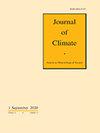PNA nonlinearity and ENSO transition asymmetry weaken PMM before La Niña onset
IF 4
2区 地球科学
Q1 METEOROLOGY & ATMOSPHERIC SCIENCES
引用次数: 0
Abstract
Abstract The Pacific Meridional Mode (PMM) is one of dominant coupled modes in the northeastern tropical Pacific (NETP), characterized by a strip-like sea surface temperature (SST) anomalies spanning from Baja California to the central equatorial Pacific. While the majority of the El Niño events follow a positive PMM, only a few La Niña events are preceded by a negative PMM. Such an asymmetric activity of PMM before the onset of El Niño-Southern Oscillation (ENSO) was previously attributed to the inherent nonlinear response of the wind-evaporation-SST (WES) feedback to trade winds in NETP. Through data analysis and coupled model experiments, we pointed out that PMM is in fact a highly symmetric phenomenon, and the asymmetry of PMM before ENSO onset thus must be associated with ENSO. On the one hand, the nonlinear response of deep convection over the equator to symmetric ENSO forcing in the central equatorial Pacific permits a stronger Pacific North America (PNA) pattern in El Niño years than in La Niña years. On the other hand, since the majority of La Niña events are preceded by a sharp decay of an El Niño, the warm equatorial SST anomalies associated with the preceding El Niño provides another source to trigger PNA before La Niña onset. The two mechanisms modulate the trade winds and heat fluxes in NETP more heavily before La Niña onset than the El Niño onset, and equally contribute to PMM asymmetry before ENSO onset.PNA 非线性和厄尔尼诺/南方涛动过渡不对称削弱了拉尼娜现象开始前的 PMM
摘要 太平洋经向模式(PMM)是东北热带太平洋(NETP)的主要耦合模式之一,其特点是海面温度(SST)异常呈条状,从下加利福尼亚一直延伸到赤道太平洋中部。大多数厄尔尼诺现象是在正的 PMM 之后发生的,而只有少数拉尼娜现象是在负的 PMM 之前发生的。在厄尔尼诺-南方涛动(ENSO)开始之前,这种不对称的 PMM 活动以前被认为是由于风-蒸发-SST(WES)反馈对 NETP 中信风的固有非线性响应造成的。通过数据分析和耦合模式试验,我们指出 PMM 实际上是一种高度对称的现象,因此 ENSO 发生前 PMM 的非对称性必然与 ENSO 有关。一方面,赤道上空的深层对流对赤道太平洋中部对称厄尔尼诺/南方涛动强迫的非线性响应,使得厄尔尼诺年的北美太平洋(PNA)模式比拉尼娜年更强。另一方面,由于大多数拉尼娜现象之前都有一个厄尔尼诺现象的急剧衰减,与之前厄尔尼诺现象相关的赤道暖海温异常为在拉尼娜现象开始之前触发 PNA 提供了另一个来源。这两种机制在拉尼娜现象发生前对NETP中信风和热通量的调节作用比在厄尔尼诺现象发生前更大,在厄尔尼诺/南方涛动发生前同样会造成PMM的不对称。
本文章由计算机程序翻译,如有差异,请以英文原文为准。
求助全文
约1分钟内获得全文
求助全文
来源期刊

Journal of Climate
地学-气象与大气科学
CiteScore
9.30
自引率
14.30%
发文量
490
审稿时长
7.5 months
期刊介绍:
The Journal of Climate (JCLI) (ISSN: 0894-8755; eISSN: 1520-0442) publishes research that advances basic understanding of the dynamics and physics of the climate system on large spatial scales, including variability of the atmosphere, oceans, land surface, and cryosphere; past, present, and projected future changes in the climate system; and climate simulation and prediction.
 求助内容:
求助内容: 应助结果提醒方式:
应助结果提醒方式:


